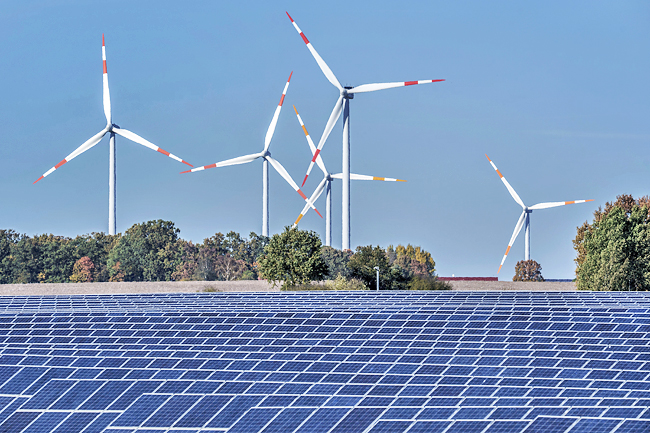In Short : A new report reveals that wind and solar energy capacity in the United States has tripled over the past decade. This significant growth reflects the increasing adoption of renewable energy sources and the country’s efforts to transition away from fossil fuels. The expansion of wind and solar power signifies a positive shift toward cleaner, more sustainable energy production, contributing to the reduction of carbon emissions and the fight against climate change. This trend highlights the ongoing progress in the renewable energy sector, marking a crucial step toward a greener and more environmentally friendly future.
In Detail :
BOSTON : The United States produced more than three times as much solar, wind and geothermal power than we did in 2013, with growth in all 50 states. That’s according to Renewables on the Rise 2023, an online dashboard unveiled on Wednesday by Environment America Research & Policy Center and Frontier Group.
“Abundant and clean renewable energy sources, most notably wind and solar, are increasingly playing a leading role in how we power our lives,” said Johanna Neumann, senior director of Environment America Research & Policy Center’s Campaign for 100% Renewable Energy. “The sooner we power our lives with renewable energy, the better it will be for our health and our planet.”
The Renewables on the Rise 2023 dashboard compiles information from various sources to detail progress over the past decade in six areas — wind, solar, electric vehicles, electric vehicle charging, energy efficiency and battery storage — that will be key to transitioning to a future powered entirely by clean and renewable resources.
Topline findings include:
The United States produced enough wind energy to power nearly 41 million typical homes in 2022 – 2.6 times as much wind energy as in 2013.
The U.S. produced enough solar energy to power 19 million homes in 2022 – nearly 12 times as much solar energy as in 2013.
The U.S. had 8.9 gigawatts of battery energy storage at the end of 2022, 60 times as much as in 2013 and 85 percent more than at the end of 2021, helping to support the use of more renewable energy and keep the lights on during extreme weather and times of grid stress.
Energy efficiency improvements installed in 2021 will save 300 terawatt-hours of power over their lifetimes – enough to power 28 million homes for a year. Energy efficiency savings increased by about 20% between 2013 and 2021, the last year for which information is available.
Americans bought more than 925,000 plug-in electric vehicles in 2022 – a more than 10-fold increase from 2013. Meanwhile, the number of electric vehicle chargers nationwide exceeded 151,000 – a nearly 18-fold increase from 2013.
14 states produce the equivalent of 30% or more of their electricity consumption from wind, solar and geothermal, up from just two states in 2013.
Together, the four states that produce the most solar energy generate enough to power 10 million households.
“Repowering America with clean energy is a nationwide project, with benefits for people in all 50 states,” said Tony Dutzik, associate director and senior policy analyst for Frontier Group. “The Renewables on the Rise dashboard highlights not only the impressive achievements of the states that are long-time clean energy leaders, but also promising signs of growth in states across the country.”
California, Texas and Florida saw the most solar power and battery storage growth from 2013 to 2022, while Texas, Iowa and Oklahoma topped the charts for wind power growth. Illinois, New Jersey and Michigan were the states with the biggest increases in savings from electric energy efficiency programs from 2013 to 2021. California, Florida and Texas top the rankings for electric vehicle sales in 2022 and California, New York and Florida have seen the greatest rise in public EV charging ports since 2013.
The Inflation Reduction Act, passed by Congress and signed by President Joe Biden in summer 2022, continues federal tax credits for renewable energy, such as wind and solar, through 2032. It also provides rebates for home efficiency upgrades and the purchase of heat pumps, electric induction stoves and other efficient electric appliances and equipment. In addition, the Inflation Reduction Act provides tax incentives to encourage individuals and businesses to buy electric vehicles.
“Given the sheer abundance of renewable energy, the keys to a future powered by 100% percent renewable energy are within reach for every state,’ said Neumann. “Now is the time for governors and state lawmakers to take those keys, grab the wheel and commit to a clean energy future as their destination.”
The authors recommend that state and local governments set clean energy goals, and then make plans and leverage federal resources to hit them. Lawmakers should ensure that utility policies fully and fairly compensate investors in clean energy technology and adopt policies for permitting and interconnection that make adopting clean energy technologies easy and hassle-free. States and localities should also cut energy waste by continuing and expanding efficiency programs and policies, including utility energy efficiency programs, energy codes for buildings, and appliance efficiency standards.

